



Table of Contents
- Introduction
- Best Places to Visit in Hampi
- Things to Do in Hampi
- Conclusion
- Faq's
Introduction
Hampi, a UNESCO World Heritage site, is a treasure trove of historical and architectural wonders. Located in the state of Karnataka, India, Hampi was once the thriving capital of the Vijayanagara Empire. The city, known for its rich history and stunning ruins, is spread over a sprawling landscape dotted with ancient temples, majestic structures, and captivating monuments. Each site in Hampi tells a story of a bygone era, offering a glimpse into the grandeur and cultural richness of the Vijayanagara period.
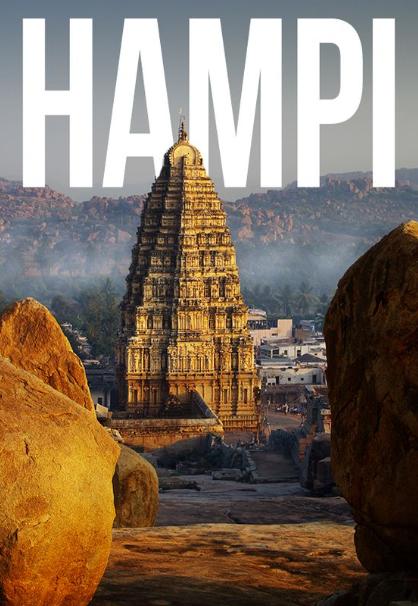 Hampi
Hampi
Image Source: Pinterest
Today, Hampi stands as a vast open-air museum showcasing the grandeur of its past. Visitors can wander through the well-preserved ruins, marvel at the intricate carvings, and immerse themselves in the vibrant history that the city embodies. The seamless blend of natural beauty and architectural brilliance creates a unique and enchanting atmosphere, making Hampi a destination that appeals to a wide range of interests. Whether you are an avid historian, an architecture enthusiast, or simply a curious traveler, Hampi promises to captivate your imagination.
In this article, we will explore the top places to visit in Hampi, ensuring your visit is both memorable and enriching. From the towering Virupaksha Temple and the iconic Vittala Temple to the serene Riverside Ruins and the picturesque Hemakuta Hill Temples, we will guide you through the must-see sites and hidden gems of this historic town. Prepare to embark on a journey through time, discovering the timeless charm and vibrant culture that make Hampi an unparalleled travel destination.
Best Places to Visit in Hampi
Virupaksha Temple
 Virupaksha Temple
Virupaksha Temple
Image Source: Pinterest
One of the oldest functioning temples in India, Virupaksha Temple is dedicated to Lord Shiva. The temple's towering gopuram (gateway tower) stands at a height of 50 meters and is adorned with intricate sculptures depicting various deities and mythological scenes. The gopuram serves as an impressive entrance, leading visitors into a sprawling temple complex that includes several smaller shrines, courtyards, and a sacred pond. Inside the main sanctum, a Shiva lingam is enshrined, drawing devotees and visitors alike. The annual chariot festival, held in the temple, attracts thousands of devotees and features a grand procession with a beautifully decorated chariot, showcasing the vibrant religious traditions of the region. The Virupaksha Temple is not just a religious center but also a historical landmark, exemplifying the architectural brilliance of the Vijayanagara era.
Vittala Temple
 Vittala Temple
Vittala Temple
Image Source: Pinterest
Known for its stunning stone chariot and musical pillars, the Vittala Temple complex is a testament to the architectural prowess of the Vijayanagara Empire. The stone chariot, one of the temple's main attractions, is a granite structure intricately carved to resemble a wooden chariot and stands as a symbol of Hampi's rich heritage. The main hall, with its 56 musical pillars, is a marvel to experience. Each pillar produces a musical note when struck, creating a mesmerizing effect that has intrigued visitors for centuries. The temple complex also includes various halls, shrines, and courtyards, all adorned with detailed carvings depicting scenes from Hindu mythology. The temple's grandeur and detailed artistry make it a highlight of any visit to Hampi, offering a deep insight into the cultural and artistic achievements of the Vijayanagara period.
Hampi Bazaar
 View of Hampi Bazaar from Matanga Hill
View of Hampi Bazaar from Matanga Hill
Image Source: Wiki
Adjacent to the Virupaksha Temple, Hampi Bazaar is a bustling street that once served as a market for precious gems and goods. Spanning over a kilometer, the bazaar was a thriving commercial hub during the Vijayanagara Empire, where traders from different parts of the world would come to buy and sell their wares. Today, it offers a glimpse into the local culture with shops selling handicrafts, souvenirs, and local delicacies. You can find items like traditional jewelry, colorful textiles, and handcrafted artifacts. The bazaar also features ancient pavilions and a Nandi bull statue at the eastern end, adding to its historical charm. Exploring the bazaar gives you a sense of the vibrant trade and daily life that once flourished in Hampi, making it a fascinating stop for both history enthusiasts and casual visitors.
Matanga Hill
 Matanga Hill
Matanga Hill
Image Source: Pinterest
For the best panoramic views of Hampi, a trek up Matanga Hill is essential. The hill provides breathtaking sunrise and sunset vistas, making it a favorite spot for photography enthusiasts. The trek to the summit is moderately challenging but rewarding, offering stunning views of the surrounding ruins, temples, and the Tungabhadra River. At the top, you'll find the Veerabhadra Temple, dedicated to an incarnation of Lord Shiva. The temple, though small, adds a spiritual touch to the serene landscape. The hill's vantage points offer a comprehensive view of the entire Hampi landscape, making it an unforgettable experience. The combination of natural beauty and historical significance makes Matanga Hill a must-visit for anyone exploring Hampi.
Elephant Stables
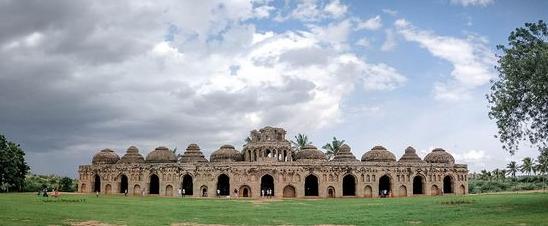 Elephant Stables
Elephant Stables
Image Source: Pinterest
These impressive stables were used to house the royal elephants of the Vijayanagara Empire. The symmetrical architecture and expansive grounds are a visual delight. The structure consists of eleven large domed chambers, each designed to accommodate an elephant. The central chamber features a taller, more ornate dome, indicating its use for ceremonial purposes. The stables are built in the Indo-Islamic style, reflecting the diverse architectural influences of the period. Visiting the elephant stables provides insight into the grandeur and scale of the empire's infrastructure and their importance in royal processions and ceremonies. The well-preserved structure offers a glimpse into the royal lifestyle and the significant role elephants played in the empire's military and ceremonial activities.
Queen's Bath
 Queen's Bath
Queen's Bath
Image Source: Pinterest
An ornate structure used by the royal family, the Queen's Bath is a testament to the luxurious lifestyle of the Vijayanagara royals. The bathhouse features an elaborate design with arched corridors, balconies, and lotus-shaped fountains. The central bathing area, surrounded by a sunken pool, is open to the sky, allowing natural light to illuminate the space. The bath's outer walls are plain, while the interior is adorned with intricate stucco work and ornamental motifs, creating a stark contrast. The combination of functional design and aesthetic beauty in Queen's Bath reflects the sophisticated lifestyle of the royals. Exploring the Queen's Bath offers a unique perspective on the private lives of the Vijayanagara royalty and their appreciation for luxury and comfort.
Lotus Mahal
 Lotus Mahal
Lotus Mahal
Image Source: Pinterest
Located in the Zenana Enclosure, Lotus Mahal is known for its lotus-like design and Indo-Islamic architecture. The two-story structure features arched windows, balconies, and an elaborate roof resembling a blooming lotus. The Mahal served as a socializing area for the royal women and is equipped with an ancient air-conditioning system that kept the interiors cool. The unique blend of Hindu and Islamic architectural elements makes it a standout structure in Hampi. The Lotus Mahal is a symbol of the cultural amalgamation that existed during the Vijayanagara period and showcases the architectural innovation of that era. Its elegant design and serene surroundings make it a highlight of the Zenana Enclosure.
Hazara Rama Temple
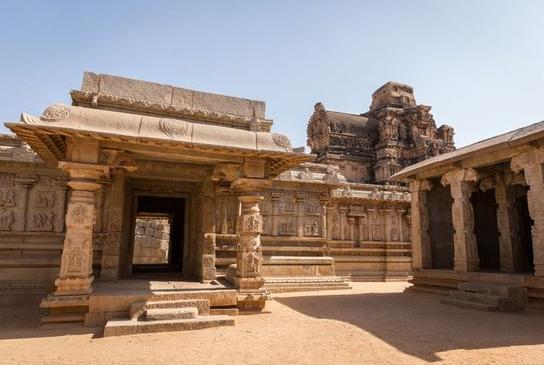 Hazara Rama Temple
Hazara Rama Temple
Image Source: Pinterest
Famous for its exquisite bas-reliefs depicting scenes from the Ramayana, the Hazara Rama Temple was the private temple of the royal family. The temple's inner sanctum houses an idol of Lord Rama, while the walls of the temple complex are adorned with detailed carvings illustrating the epic's various episodes. The temple also features intricately carved pillars and an open hall used for public ceremonies. The artistic and historical significance of the Hazara Rama Temple makes it a must-visit for history and art enthusiasts. The temple serves as a testament to the devotion and artistic excellence of the Vijayanagara craftsmen, offering a deep insight into the empire's religious and cultural heritage.
Hippie Island
 Hippie Island
Hippie Island
Image Source: Pinterest
For a more laid-back experience, head to Hippie Island (Virapapur Gaddi). This area offers a stark contrast to the historical sites, with its vibrant cafes, relaxed atmosphere, and opportunities for kayaking and other adventure activities. The island is popular among backpackers and offers budget accommodations, live music events, and yoga retreats. You can rent a scooter to explore the scenic countryside, visit the nearby Sanapur Lake, or simply relax by the river. Hippie Island is perfect for those looking to unwind and enjoy the natural beauty of Hampi in a more casual setting. The island's bohemian vibe and scenic beauty make it a favorite spot for travelers seeking a different side of Hampi.
Tungabhadra River
 Tungabhadra River
Tungabhadra River
Image Source: Pinterest
The lifeline of Hampi, the Tungabhadra River is not just a scenic spot but also offers coracle rides. These traditional round boats provide a unique way to explore the river and its surroundings. The riverbanks are dotted with ancient ruins, temples, and carvings, offering a different perspective of Hampi's rich heritage. You can also enjoy a peaceful picnic by the river, visit the picturesque Anjaneya Hill across the river, or simply take in the natural beauty of the area. The Tungabhadra River adds a serene and picturesque element to the Hampi experience, making it a perfect spot for relaxation and exploration. The calm waters and scenic landscapes make the river an integral part of any visit to Hampi, offering both adventure and tranquility.
Hemakuta Hill Temples
 Hemakuta Hill
Hemakuta Hill
Image Source: Pinterest
This cluster of temples is set atop Hemakuta Hill, offering visitors a serene and picturesque setting perfect for peaceful exploration. The hill is dotted with numerous shrines and small temples, many of which date back to the early Vijayanagara period. The strategic location of the hill provides stunning panoramic views of the surrounding landscape, making it a popular spot for both sunrise and sunset views. Visitors can wander through the ruins, appreciating the architectural beauty and historical significance of this site. The temples' intricate carvings and the tranquility of the hilltop create a spiritually uplifting experience, making it a must-visit for history buffs and nature lovers alike.
Achyutaraya Temple
 Achyutaraya Temple
Achyutaraya Temple
Image Source: Pinterest
Nestled between Matanga Hill and Gandhamadana, the Achyutaraya Temple is a less crowded but equally magnificent site. Constructed in the 16th century, this temple is dedicated to Lord Tiruvengalanatha, an incarnation of Vishnu. The temple complex includes a spacious market street, known as the Achyutaraya Bazaar, which provides a fascinating glimpse into the social and economic life of the Vijayanagara period. The intricate carvings and expansive courtyards offer a tranquil environment for visitors to explore at leisure. The architectural details and serene surroundings make the Achyutaraya Temple a hidden gem in Hampi, perfect for those seeking a more peaceful and intimate exploration.
Kadalekalu Ganesha
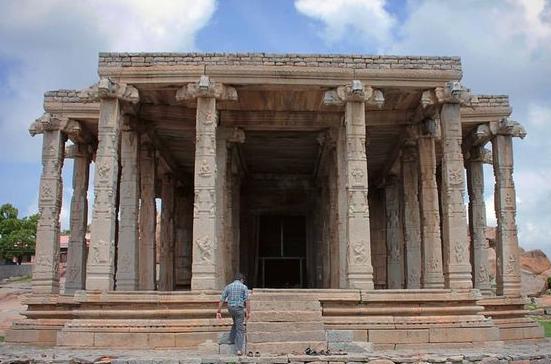 Kadalekalu Ganesha
Kadalekalu Ganesha
Image Source: Pinterest
Located on the slope of Hemakuta Hill, the Kadalekalu Ganesha is a massive monolithic statue of Lord Ganesha, carved from a single boulder. Standing at an impressive 4.6 meters (15 feet) high, the statue is one of the largest representations of Ganesha in Hampi. The fine craftsmanship is evident in the detailed carvings, which showcase the skill of the artisans of the time. The statue's serene expression and majestic presence make it a must-visit site for devotees and tourists alike. The location on the scenic hillside adds to the charm, offering visitors a chance to enjoy the natural beauty and the artistic heritage of Hampi simultaneously.
Sasivekalu Ganesha
 Sasivekalu Ganesha
Sasivekalu Ganesha
Image Source: Pinterest
Situated near the Kadalekalu Ganesha, the Sasivekalu Ganesha is another remarkable monolithic statue of Lord Ganesha. The name 'Sasivekalu' translates to 'mustard seed,' a reference to the statue's shape. This statue stands at 2.4 meters (8 feet) high and is housed in an open pavilion, which provides a perfect frame for the idol. The intricate details and serene setting make it a popular spot for visitors seeking to appreciate ancient art and spirituality. The open-air pavilion allows for unobstructed views of the statue, enhancing the overall experience of admiring this ancient masterpiece.
Krishna Temple
 Krishna Temple
Krishna Temple
Image Source: Pinterest
Built-in 1513 AD by the illustrious King Krishnadevaraya to commemorate his victory over the Gajapati rulers of Orissa, the Krishna Temple is dedicated to Lord Krishna. The temple complex is renowned for its exquisite carvings and inscriptions, which depict various scenes from the life of Krishna. The detailed sculptures and well-preserved architecture provide a vivid glimpse into the grandeur of the Vijayanagara Empire. This temple is a testament to the empire's devotion to art and religion. The lush courtyards and the impressive gateways further add to the temple's charm, making it a key highlight of any visit to Hampi.
Daroji Bear Sanctuary
 Daroji Bear Sanctuary
Daroji Bear Sanctuary
Image Source: Pinterest
A short drive from Hampi, the Daroji Bear Sanctuary is a haven for wildlife enthusiasts. The sanctuary is home to a significant population of sloth bears, along with other wildlife such as leopards, hyenas, and various bird species. Visitors can embark on guided safaris to spot these elusive creatures in their natural habitat. The sanctuary's lush landscape and diverse flora make it a perfect getaway for nature lovers and wildlife photographers. The opportunity to observe sloth bears foraging and interacting in their natural environment provides a unique and memorable wildlife experience.
Anegundi Village
 Anegundi Village
Anegundi Village
Image Source: Pinterest
Located across the Tungabhadra River, Anegundi is an ancient village with deep historical and mythological significance. Believed to be the mythical Kishkinda from the Ramayana, Anegundi predates the Vijayanagara Empire and is filled with ruins, temples, and traditional houses. Visitors can explore the picturesque village, visiting sites like the Anjanadri Hill (believed to be the birthplace of Hanuman) and the Pampa Sarovar. The village offers a charming blend of history, culture, and natural beauty. Strolling through Anegundi, you can experience the tranquil rural life, interact with locals, and appreciate the village's historical and cultural richness.
Mahanavami Dibba
 Mahanavami Dibba
Mahanavami Dibba
Image Source: Pinterest
The Mahanavami Dibba is a grand stone platform that was used by the Vijayanagara kings to watch the annual Dasara processions and other royal ceremonies. The platform stands tall with its intricately carved steps and sides, depicting scenes from daily life, hunting, and royal processions. From the top of the platform, visitors can enjoy a panoramic view of the surrounding area, including other ruins and the lush landscape. This site provides a fascinating insight into the grandeur of royal ceremonies and celebrations. The elevated vantage point and the detailed carvings make Mahanavami Dibba a significant and impressive historical site.
Riverside Ruins
 Riverside Ruins
Riverside Ruins
Image Source: Pinterest
A leisurely walk along the banks of the Tungabhadra River reveals a series of ancient ruins that are both serene and picturesque. The Riverside Ruins include the Kodanda Rama Temple, numerous shrines, and intricately carved stones scattered along the riverbank. This area offers a tranquil escape from the more crowded sites, allowing visitors to immerse themselves in the peaceful ambiance and historical richness of the riverside. The combination of natural beauty and ancient architecture creates a unique and serene environment, perfect for a contemplative and relaxed exploration.
Underground Temple
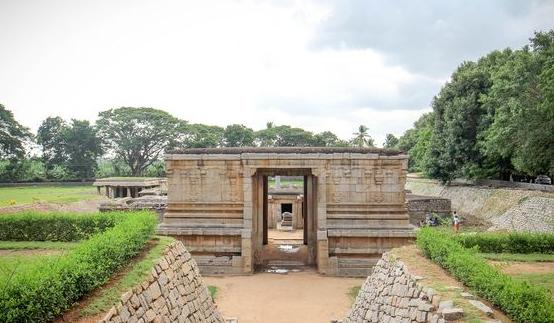 Prasanna Virupaksha Temple
Prasanna Virupaksha Temple
Image Source: Pinterest
Also known as the Prasanna Virupaksha Temple, the Underground Temple is dedicated to Lord Shiva and is partially submerged, adding to its mystique. The temple is often filled with water, creating an eerie and fascinating atmosphere. Visitors can explore the dimly lit corridors and chambers, which are adorned with carvings and inscriptions. The unique setting and enigmatic aura make the Underground Temple a captivating destination for those interested in ancient architecture and spirituality. The temple's submerged nature and the sense of hidden history add to the allure, making it a memorable and intriguing site in Hampi.
Things to Do in Hampi
- Explore the Ruins
Hampi is a UNESCO World Heritage Site, renowned for its extensive array of ruins and monuments that span over 4,100 hectares. The ruins, which date back to the Vijayanagara Empire, include majestic temples, royal pavilions, market streets, and intricately carved pillars. To fully appreciate the historical significance and architectural marvels of these sites, a guided tour is highly recommended. Knowledgeable guides can provide detailed insights into the history, culture, and legends associated with each monument, making your exploration both informative and engaging. Key highlights include the Vittala Temple with its musical pillars, the Virupaksha Temple, and the royal enclosure.
- Rock Climbing
The boulder-strewn landscape of Hampi offers an exhilarating experience for rock climbing enthusiasts. The unique terrain, characterized by massive granite boulders, provides a range of climbing opportunities suitable for both beginners and experienced climbers. Popular climbing spots include the Hemakuta Hill, Matanga Hill, and the area around the Virupaksha Temple. The rugged beauty of the area, combined with the thrill of scaling these ancient rocks, makes for an unforgettable adventure. Local climbing guides are available to assist and ensure safety, offering tips and routes that cater to varying skill levels.
- Bird Watching
Hampi's diverse landscape, which includes riverbanks, hills, and forests, is a haven for bird watchers. The region is home to a variety of bird species, including resident and migratory birds. Early mornings and late afternoons are the best times for bird watching, as the birds are most active during these periods. Popular bird-watching spots include the Tungabhadra River, the Daroji Bear Sanctuary, and the paddy fields around Hampi. Bird enthusiasts can spot species such as the painted stork, peafowl, kingfisher, eagle, and various waterfowl. A pair of binoculars and a field guide can enhance the bird-watching experience, allowing you to identify and appreciate the rich avian diversity of the area.
- Cycling Tours
Renting a bicycle and exploring Hampi on two wheels is an eco-friendly and enjoyable way to see the sights. The vast archaeological site and its surrounding landscape are perfect for cycling, offering a mix of paved and dirt trails that lead to various ruins, temples, and scenic spots. Several rental shops provide bicycles, and guided cycling tours are available to help you navigate the area and learn about its history. Cycling allows you to cover more ground at your own pace, stopping to explore lesser-known ruins and hidden gems along the way. It's a great way to soak in the natural beauty and historical richness of Hampi while getting some exercise.
- Attend Local Festivals
If your visit coincides with local festivals like the Hampi Utsav, you'll get to experience the vibrant culture and traditions of the region. The Hampi Utsav, also known as the Vijaya Utsav, is a cultural extravaganza held annually, celebrating the legacy of the Vijayanagara Empire. The festival features a variety of events, including traditional music and dance performances, puppet shows, processions, and fireworks. It's a wonderful opportunity to immerse yourself in the local culture, witness traditional art forms, and enjoy the festive atmosphere. Other local festivals may include religious celebrations at the temples, which are equally vibrant and culturally enriching.
- Coracle Rides
Experience the traditional coracle ride on the Tungabhadra River. These circular bamboo boats, known locally as 'teppa,' have been used for centuries and offer a unique way to see the river and its surroundings. A coracle ride provides a peaceful and scenic journey along the river, allowing you to view the riverside ruins, temples, and natural landscapes from a different perspective. The gentle movement of the boat and the serene environment create a relaxing and enjoyable experience. It's also an opportunity to learn about the traditional boat-making techniques and the historical significance of these vessels in local life.
- Heritage Walks
Joining a heritage walk is a fantastic way to delve deeper into the history and architecture of Hampi. These guided walks are typically led by knowledgeable local guides who provide detailed insights into the historical significance, legends, and architectural styles of various sites. As you stroll through the ancient streets, temples, and ruins, you'll learn about the rise and fall of the Vijayanagara Empire, the daily life of its inhabitants, and the artistry that went into creating these magnificent structures. Heritage walks often include visits to major landmarks like the Virupaksha Temple, the Vittala Temple, the royal enclosures, and other lesser-known but equally fascinating spots.
- Photography Tours
Hampi's dramatic landscape and ancient ruins make it a paradise for photographers. Specialized photography tours are available to help you capture the best shots of this ancient city. These tours are often led by experienced photographers who know the ideal times and angles to shoot various sites. Whether you're interested in landscape photography, architectural details, or candid shots of local life, these tours can provide valuable tips and guidance. The golden hours of sunrise and sunset offer particularly stunning lighting, casting a magical glow over the boulders and temples. Bring your camera and get ready to capture the timeless beauty of Hampi.
- Local Cuisine
Don't miss the opportunity to try the local Karnataka cuisine while in Hampi. The local eateries and restaurants offer a variety of mouth-watering dishes that reflect the rich culinary traditions of the region. Traditional thalis, which include a selection of rice, bread, curries, and accompaniments, provide a hearty and flavorful meal. Other popular dishes include dosas (thin rice pancakes), idlis (steamed rice cakes), vadas (savory fritters), and various types of chutneys and sambars. For a sweet treat, try the famous Mysore Pak, a rich and buttery dessert. Dining in Hampi allows you to savor the authentic flavors and spices of Karnataka, making your visit even more memorable.
Conclusion
Hampi is a destination that offers a perfect blend of history, architecture, and natural beauty. From the ancient ruins and majestic temples to the serene riverside and lush landscapes, Hampi provides a rich tapestry of experiences. History buffs will be captivated by the detailed carvings, grand structures, and the stories of the Vijayanagara Empire. Adventure seekers can indulge in activities like rock climbing, cycling, and trekking up scenic hills, while nature lovers will appreciate the tranquil surroundings and opportunities for wildlife spotting. The vibrant local culture, reflected in the bustling bazaars and traditional festivals, adds to the allure of this historic town.
Whether you are exploring the intricate architecture of temples, enjoying a peaceful coracle ride on the Tungabhadra River, or simply relaxing in the serene atmosphere, Hampi has something for everyone. Plan your trip to Hampi in 2024 to experience its timeless charm and vibrant culture. The combination of historical significance, natural beauty, and cultural richness makes Hampi a must-visit destination that promises to leave a lasting impression on every traveler.
explore further
Latest from Location Reviews
More from Recommendations
Resources
Dwello, for every home buyer, is a way to go from 'I feel' to 'I know', at no extra cost.




